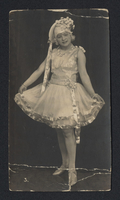Overview
- Brief Narrative
- White wimpel (or Torah binder) with a multi-colored, painted inscription created for Eric Junker. It was brought with the family when they left Aschaffenburg, Germany, for the United States in July 1937, and displayed at Eric's funeral in 2012. A wimpel is used as a binder to keep a Torah scroll tightly wound when not in use. It was a German custom to make a wimpel from the swaddling cloth used at the circumcision ceremony (brit malah), which was performed when a male infant was eight days old. The cloth was usually hand-decorated by the mother or another close family member. After the Nazi regime took power in 1933, authorities quickly began suppressing the rights and personal freedoms of Jews, and boycotting their businesses. Eric's father, Fred, traveled alone to the United States in November 1936. After getting settled in Philadelphia, Fred brought his family over as well. Eric, his brother, Herbert, their mother, Betty, and their grandmother, Martha Keller, arrived in July 1937. Eric’s sister, Lillian, was born in 1939. Later on, in 1955, Eric became a naturalized US citizen.
- Date
-
commemoration:
1935
use: 2012
- Geography
-
received:
Aschaffenburg (Germany)
- Credit Line
- United States Holocaust Memorial Museum Collection, Gift of Florine Junker
- Contributor
-
Subject:
Eric Junker
- Biography
-
Erich Junker (later Eric, 1935-2012) was born in Aschaffenburg, Germany, to Friedrich (Fritz, later Fred, 1900-1980) and Betty (nee Keller, 1905-2005) Junker. Erich had an older brother, Herbert (b. 1933). They were among nearly 600 Jewish families living in Aschaffenburg. Friedrich worked as a clerk and served in the German infantry during World War I. On January 30, 1933, Adolf Hitler was appointed chancellor of Germany by President Paul von Hindenburg. Under Hitler, authorities quickly began suppressing the rights and personal freedoms of Jews, and boycotting their businesses.
In November 1936, Friedrich traveled alone to the United States, while Betty took the children to her family in Worms. Friedrich initially stayed in New York City with his brother, Max (1897-1990), who had immigrated in 1930. Friedrich Americanized his name to Fred, and soon moved to Philadelphia, where he worked as an order clerk at Rosenau Brothers, a children’s clothing manufacturer. The company was founded by a cousin of Fred’s father, Fred J. Rosenau. After getting settled in Philadelphia, Fred brought his family over as well. Betty, the children, and her mother Martha Keller (nee Metzger, 1880-1937) arrived in July 1937. Martha died that November. Fred later left Rosenau Brothers, and opened his own dress shop. Erich Americanized his name to Eric, and became a naturalized US citizen in May 1955. Eric was married twice, to Rosalie Polsky (b. 1939) and Florine Jaffee (b. 1936), and had five children.
Physical Details
- Classification
-
Jewish Art and Symbolism
- Category
-
Jewish ceremonial objects
- Object Type
-
Torah binders (lcsh)
- Genre/Form
- Religious articles.
- Physical Description
- Long, narrow, rectangular, lightweight white cloth band with a gold satin-like cloth border machine stitched around the edge. Handpainted, multicolored Hebrew characters and decorations, including a crown, flowers, a stylized bird, flowering branches, a crowned lion, and a Torah scroll extend the length of the band, which is made from 3 joined sections. A name is painted in German beneath the characters on the lower right. Penciled guidelines are visible around several words.
- Dimensions
- overall: Height: 13.250 inches (33.655 cm) | Width: 114.750 inches (291.465 cm)
- Materials
- overall : cloth, paint, thread, graphite
- Inscription
- front, multi-colored paint : Hebrew text [Elazar (or Eliezer) ben Yosef nolad BMZT (be-mazal tov) be-yom daled Tishre TaRTsaV LaPak. Yigdal be-Torah ule-hupah u-lema'asim tovim Amen selah. Translation: Elazar (or Eliezer) the son of Joseph was born with good luck on the 4th day of Tishrei Tav Resh Tsade Vav (1935). May he grow (to study) Torah, to stand under the hupah (be married), and do good deeds. Amen.]
front, lower right, blue and yellow paint : ERICH JUNKER
Rights & Restrictions
- Conditions on Access
- No restrictions on access
- Conditions on Use
- No restrictions on use
Keywords & Subjects
- Topical Term
- Americanization. Antisemitism--Germany. Bar mitzvah. Child refugees--United States--Biography. Dressmakers. Jewish families--Germany. Jewish refugees--United States--Biography. Jews--Cultural assimilation--United States. Jews--Germany--Persecution. Germany--Emigration and immigration--History--20th century. United States--Emigration and immigration--History--20th century.
- Geographic Name
- Aschaffenburg (Germany) Philadelphia (Pa.) Worms (Germany)
Administrative Notes
- Legal Status
- Permanent Collection
- Provenance
- The Torah binder was donated to the United States Holocaust Memorial Museum in 2016 by Florine Junker, the wife of Eric Junker.
- Funding Note
- The cataloging of this artifact has been supported by a grant from the Conference on Jewish Material Claims Against Germany.
- Record last modified:
- 2023-04-24 14:15:10
- This page:
- https://collections.ushmm.org/search/catalog/irn551032
Download & Licensing
In-Person Research
- By Appointment
- Request 21 Days in Advance of Visit
- Plan a Research Visit
- Request to See This Object
Contact Us
Also in Eric Junker family collection
The collection consists of a wimpel, documents, and photographs related to experiences of Erich (later Eric) Junker, his parents Fred and Betty, and brother Herbert, originally of Aschaffenburg, Germany, who immigrated to the United States in 1936-1937, as a result of anti-Semitism in Germany.
Date: 1935-1955

Junker family papers
Document
Photographs and documents related to the immigration of the family of Erich Junker, originally of Aschaffenburg, Germany, to the United States in 1936-1937, as a result of antisemitism in Germany. The collection includes photographs of the Junker family, including Eric, his parents Fred and Betty, and brother Herbert, among others; and documents related to Erich, including his birth certificate, immunization certificate, United States naturalization certificate, and related documents.



